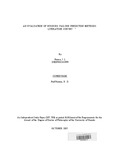| dc.description.abstract | Since the fall of Babel [the largest enterprise in the history of mankind], human corporations are always faced with the risk of failure. Just like human beings survive on sufficiency of human blood, so do businesses survive on the sufficient flow of corporate blood (funds or finances). Consequently, business failure (bankruptcy) is a concern of accounting and finance which are micro-economic tentacles of the theory of finance as applied to corporations. Both areas have grown up till they are currently pursued both professional and academic areas of specialization. Unlike accounting where the conceptual framework of has been configured, the theoretical framework of finance has not been configured despite its enormous body of known theories. This is a major contribution of this paper in its effort to locate concerns of business failure.
Beaver (1966/7) provided the earliest documented business bankruptcy prediction model. Altman (1968) perfected on the art and developed a Multiple Discriminant Analysis (MDA) model (dominantly called Z-Score Model) which dominated business failure prediction world over till late 1980. Due to technological advancement and continued increased business failures especially in the 1970's and 1980's, all over the world, alternative failure prediction models started emerging in the late 1980's and especially in the decade of 1990-1999. These non-classical models lent themselves to use large data of varying nature deviating from the classical statistical (quantitative) based models. Incidentally effectiveness of classical st~al models and non-classical models have been found more or less the same except for the timing of when the signal is emitted.
Because of timing of signals, environmental differences, industry uniqueness, diversity. of information containing variables and other regional specific factors, business failure prediction practice is currently shifting from MDA models to alternative non classical methods especially Logit Analysis Model, Multidimensional Framework Analysis, Artificial Neural Networks among others. Despite all this effort, business continue to fail; hence the question, why do businesses continue to fail? Which of these many models are relevant to East African firms? Is the usage of the models proper? | en |

